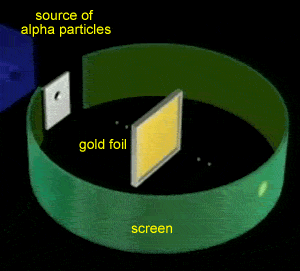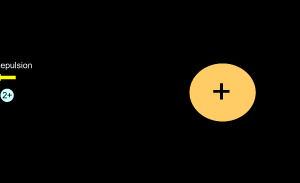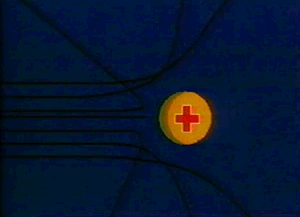
Rutherford concluded that for such a large proportion of alpha particles to pass straight through the gold foil, most of the volume of the atom is empty space.
He suggested that the small amount of particles bounced back due to repulsion by the positive matter identified by earlier physicists. This positive matter Rutherford would call the nucleus.
Still other alpha particles that passed close to this positive mass were repelled to a lesser extent and deflected away from their linear path, as shown on the right.


Rutherford's calculation revealed that the distance of closest approach was
3 X 10-14 m. However knowing that the atom had a radius of 1 X 10-10 m he concluded that the nucleus is a small, solid, positive charged mass in the vastness of the atom.
To put it into perspective, if the MCG, Melbourne Cricket Ground, was the atom the nucleus would be the size of a flea in the middle of the ground.

From his studies Rutherford concluded that the atom had a structure that resembled the solar system, where the electrons revolve around the nucleus much like planets around the sun.
In 1911 Rutherford put forward his model of the atom that proposed:
- Most of the mass and all its positive charge must be located in a central region called the nucleus;
- Most of the volume of an atom is space;
- Electrons move in circular orbits around the nucleus;
- An electrostatic attraction exists between negative electrons and the positive nucleus.
In 1914 Rutherford concluded that the fundamental particle of positive charge was the nucleus of the hydrogen atom which he called the proton. Observation made through experimentation revealed that the charge of all nuclei was equal to the charge of a proton multiplied by a whole number.
However Rutherford's model could not explain why the helium, which was known to contain two protons and two electrons was four times heavier rather that just two times heavier. The problem was even more pronounced for heavier atoms such as lead or uranium. Neutrons were yet to be discovered.
Rutherford would later reject his original explanation and propose that the nucleus contained particles with significant mass but no charge.